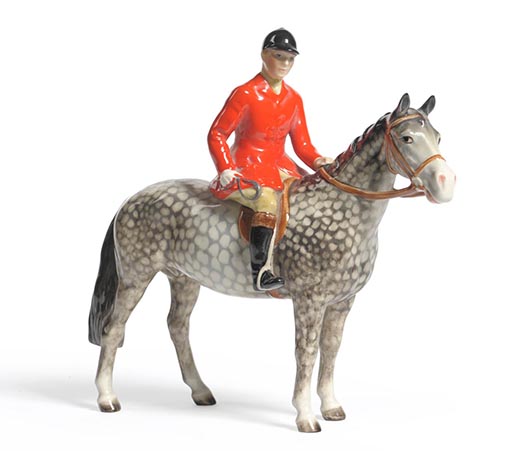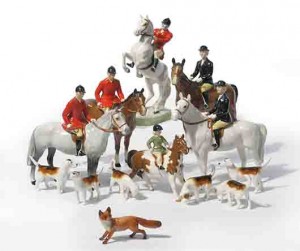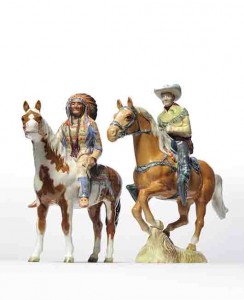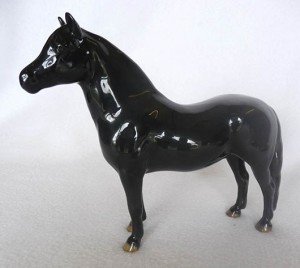LONDON – We met a dealer this week who used to deal only in high value, Royal Doulton and Beswick pottery figures. Oddly, all he’s selling now are modern reproductions of Art Nouveau and Art Deco bronzes. What had gone wrong?
Simple: Demand for his stock had fallen away to such a degree that he had decided to cut his losses and sell up. Quite possibly dozens of his customers up an down the country are wising they could do the same, their china cabinets bearing witness to purchases made for investment rather than love.
It’s never a good plan, particularly where antiques are concerned.
There was a time when Beswick was fetching astronomical prices. I recall witnessing the London sale of the contents of the Beswick Museum in 2003, following the factory’s closure. One lot in particular, Kruger the pit pony, set a world auction record.
Beswick made only four copies of Kruger to commemorate the opening by Princess Anne of Chatterley Whitfield Mining Museum, in Tunstall, Stoke-on-Trent, in 1987.
Kruger was the last pit pony to work at Chatterley, retiring in 1931, and when museum chiefs sought an image to represent the Spirit of Whitfield, which ceased as a working colliery in 1978, the little Welsh cob was the ideal choice.
The figure was modeled by Beswick chief designer Graham Tongue, but oddly – and unlike any other piece produced by the factory – was never given a shape number.
Today, one of the four remains in the Royal Collection; one can be seen in the mining museum, and the third was sold in an auction in 1994 for 2,750 pounds. I watched the fourth sell for a 11,352 pounds with buyer’s premium. What price now, I wonder?
Beswick is arguably best known for its highly detailed figure groups of wild and domestic animals and a range of racehorses including Red Rum, Nijinsky and even thoroughbreds owned by the Queen.
The move was the idea of Beswick chief modeller Arthur Gredington and later developed by decorating manager Jim Hayward. Between them they introduced more than 3,000 models during the former’s 35 years with the company.
They included cats and dogs, birds and fish, pets and wild animals, all of which rubbed shoulders with royal commemorative ware, Toby jugs and children’s characters, notably the popular Beatrix Potter figures.
Everything produced after 1936 was marked with model numbers, which simplified identification, and because of the quality of genuine pieces, reproductions are almost unheard of.
That, coupled with a host of seemingly scarce withdrawn pieces and closure meaning no new Beswick would ever be produced again created the perfect storm for rapid price spirals.
However, in this digitally connected world, trends that are viral one minute are spam the next. Beswick models or colour combinations that were once thought to be rare and valuable, proved to be quite the opposite. As word spread, more and more examples started appearing out of the ether, usually on online auction platforms where every collector can be his own auctioneer.
Such technology is also capable of helping buyers find “rare” pieces with little or no effort on their part. Type in a handful of keywords to an auction search engine and up pops examples of the objects proving, in some cases, that perhaps they are not so rare after all. The technology will even inform buyers when further pieces are posted for sale.
Rarities do continue to surface, though. North Yorkshire auctioneers Tennants uncovered a model of the Dartmoor pony called “Jentyl” Model No. 1642 in the previously unknown black colorway.
It turned out that the piece was made specially for a long-serving judge with the Dartmoor Pony Society and the owner of the last colt, produced by the mare. No other black-painted Jentyl is known – unless you know different – and the model sold for just shy of 1,000 pounds. The common brown version can be had for around 50 pounds.
An indication of how values have taken a hit is offered by prices achieved for Model No. 151, the Huntsman in the rare so-called “rocking horse gray” colorway. In 2010, a restored version sold for 3,450 pounds in a Tennants auction, while in 2012, a perfect example fetched 2,600 pounds. In 2013, another, also in perfect condition sold for 1,650 pounds.
Condition is of paramount importance. Broken legs, fins, feathers or ears, all of which are particularly vulnerable, can decimate values. Restoration, however good it might be, also kills prices, sometimes up to 90 percent off the market price, according to Tennants specialist Mark Littler.
The Charlton Standard Catalogue of Beswick Animals, now in its 10th edition is, is required reading. It lists all known models, styles, versions and variations with retail prices, although saleroom valuations are generally between a third and half lower.
The Beswick company was founded by James Wright Beswick and his son, John, in 1894 at the Baltimore Works in Longton, Stoke-on-Trent.
Initially the factory produced under-glaze printed dinner, tea and toilet wares as well as hospital wares and fancy goods, such as pots and pedestals, vases in the so-called “majolica” glazes, Toby jugs and old-English style figures.
Only later, in the 1930s, did it turn to animal modeling, notably the series of shire and famous racehorses and champion dogs.
J.W. Beswick died in 1921 and his son in 1936, whereupon the company passed into the control of grandsons John Ewart and Gilbert Beswick.
The Pottery Gazette, that bible of the industry, reported prophetically in 1961 that “No pottery formed in the last century is more likely to be of future interest to collectors than the House of Beswick.”
How right they were. Buying swept through the home market and later the U.S. and Canada, the lifelike and highly detailed and anatomically accurate modeling, meticulous hand-painting and stringent quality control ensuring a loyal following among collectors.
By then a limited company, Beswick subsequently became renowned as the finest manufacturer of animal groups and a range of whimsical figures of creatures with human expressions and in human poses.
However, with no heirs to pass the company on to, the family sold out to troubled Royal Doulton in 1969 for a reported 495,000 pounds.
Production ceased in Christmas 2002. Demand for rare and withdrawn figures spiraled out of control, collectors often pushed aside by investors who assumed they were on to surefire profits. They were, but not for long.
Pundits now rate Beswick as “a hold.”






